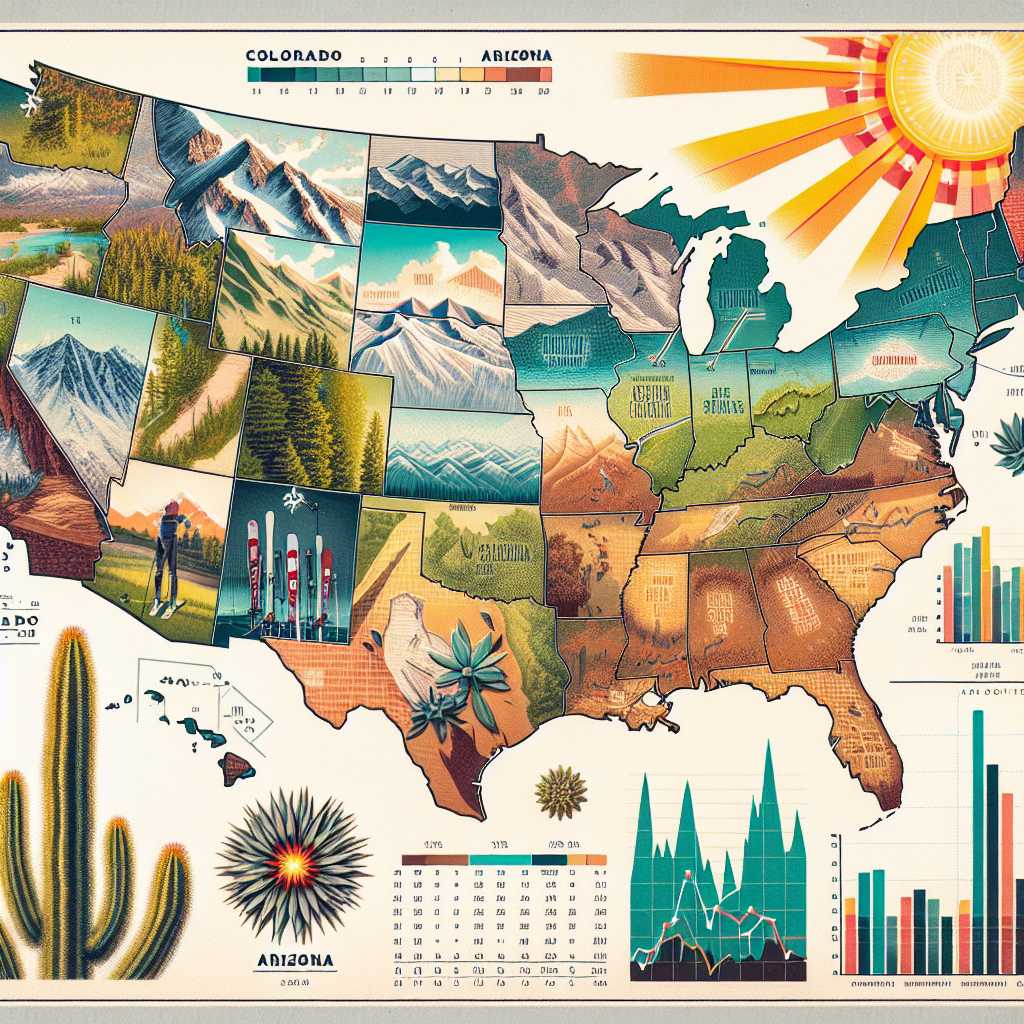Comparing Colorado and Arizona: A Diverse Landscape of Choice
Regardless of the regions you’re comparing or contrasting, it is paramount to understand that each state has its unique attributes, culture, environment, and economic landscape. In a comparison of Colorado and Arizona, one immediately notices dramatic differences in topography, climate, and cultural opportunities, as well as similarities in their evolving demographics and economic potential. Here is a closer examination of these two Southwestern U.S. states.
Geographical and Climatic Contrasts
In the comparison between Colorado and Arizona, one of the most striking differences lies in their geography and climate.
Colorado: The Elevated State with Varied Climates
Colorado is renowned for its mountainous terrain, a defining feature that greatly influences its climate and outdoor recreational opportunities. It’s home to the Rocky Mountains and several ski resorts coveted by winter sports enthusiasts worldwide. It experiences a largely dry climate but varies greatly from arid conditions in the southern plains to alpine conditions in the high mountains. Colorado’s four-season climate consists of cold, snowy winters, particularly in the mountains, and warm to hot summers with cooler evenings.
Arizona: The Desert Landscape with Year-Round Warmth
Arizona’s landscape is largely defined by its desert status; however, it also accommodates pine forests, plateaus, and mountain ranges like the San Francisco Peaks. It is most famous for the Grand Canyon which is carved by the Colorado River, showcasing dramatic Earth history visible in its strata. Arizona is typically hotter than Colorado due to its lower elevation and desert environment, reflected in long, blazing-hot summers and mild winters, especially noted in areas like Phoenix and Tucson.
Cultural Vibes: City Life vs Outdoors Living
Both states offer rich cultural experiences although they are now presented in different settings with unique characteristics.
Colorado’s Cultural Mix: Mountains Meet Metropolis
Colorado’s cultural scene is multifaceted. Denver, its capital city, melds urban sophistication with proximity to outdoor recreation. There are world-class museums, an active music scene spearheaded by venues like Red Rocks Amphitheatre, and a thriving craft brewery industry. Educational opportunities also abound here with several well-known universities thoughout the state.
Arizona’s Blend of History and Urbanity
Arizona boasts its own cultural mix shaped by Native American heritage, historical mining towns turned tourist destinations like Jerome, and larger urban centers such as Phoenix that host major sports teams and a growing nightlife scene. Additionally, universities such as Arizona State University add vibrancy to local culture through academics and athletics.
Economic Opportunities: Comparing Industries and Employment
The financial landscapes reveal distinct opportunities based on resources and demographic trends.
Colorado’s Economy: Diverse And Dynamic
Colorado has a diverse economy concentrated in scientific research, technology, manufacturing, tourism resulting from its famous slopes, and an expanding aerospace sector. Additionally, Agriculture remains significant particularly on the eastern plains where cattle ranching prevails through vast open spaces.
Arizona’s Growth: Focus on the Sunbelt Surge
Arizona’s economy reflects a boom in the service sector as population inflows contribute to increased demand for everything from health care to real estate services. Its proximity to California also benefits trade and logistics industries. Physical benefits like year-round sunny weather expand opportunities in sectors such as solar energy, while traditional mining activities continue due to abundant natural resources.
Population Demographics: Diverse and Evolving Patterns
Both states see a growing population reflecting broader national shifts.
Shifts in Colorado: An Influx of New Residents
Colorado has witnessed significant population growth recently as people move for job opportunities alongside the quality of life offered by outdoor pursuits. This influx has led to evolving demographics with increasing diversity.
Changes in Arizona: Diverse Across Generations
Similarly, Arizona has seen rapid growth driven both by its appeal as a retirement destination with warm temperatures appealing to older demographics but also attracting young families and entrepreneurs looking to capitalize on economic opportunities within the Sunbelt region.
Infrastructure Developments: Progress Amid Challenges
Building in Colorado: Winter Woes & Urban Struggles
In coping with developments needs adequate infrastructure becomes critical. In Colorado particularly stressors like heavy snowfall creating maintenance challenges for roadways and transportation have to be balanced alongside urban congestion issues associated with denser populations in cities such as Denver.
Expanding Across Arizona: Heat Challenges & Urban Sprawl
Arizona faces its own struggles adapting infrastructure needs to its rapid expansion faced with extreme heat responses necessary alongside infrastructural expansion to cater for wider urban sprawl throught out cities like Phoenix which is one fo the fastest grwoing cities within America.
Notes
Image description: A map highlighting Colorado and Arizona’s location within the USA; icons depict key features of each state – mountains and skis represent Colorado while cactus plants and sun depict Arizona; graphs or charts might illustrate population demographics or economic capacities for a comparative visualization between the two states.
